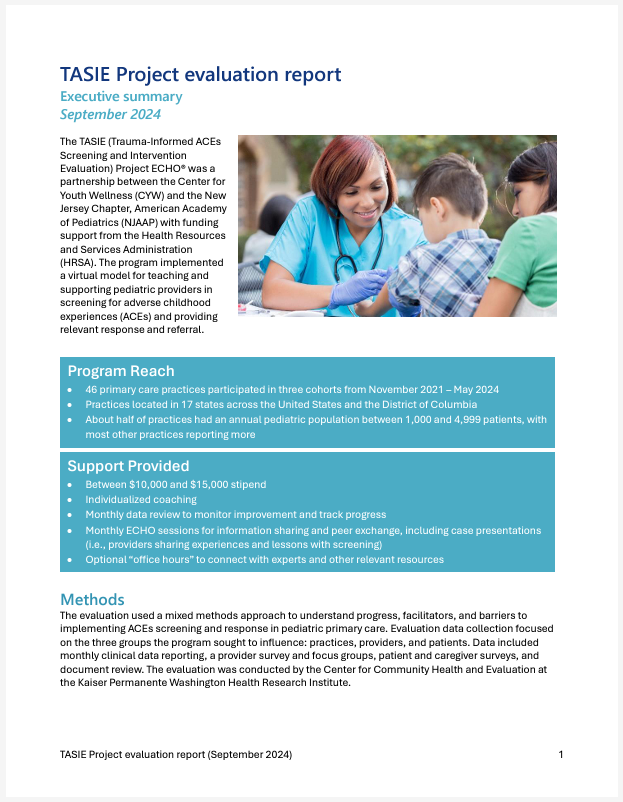Following the successful conclusion of our three-year federally funded TASIE project, the Center for Youth Wellness (CYW) team within Safe & Sound is working on a new one-year initiative in partnership with the University of California ACEs Aware Family Resilience Network (UCAAN). This multi-campus initiative—anchored at UCLA and UCSF—aims to strengthen the implementation of CalAIM services in pediatric settings when a child screens positive for Adverse Childhood Experiences (ACEs).
Through this project, Safe & Sound will provide technical assistance and training to 16 healthcare practices across California—including Alameda Family Services, Bay Area Community Health, and UCSF Benioff Children’s Hospital Oakland. Many of these practices already conduct ACEs screenings but underutilize the full range of CalAIM services available, such as Enhanced Care Management (ECM), Dyadic Services, Community Supports, and Community Health Worker services. Our goal is to bridge this gap, helping practices build integrated care models that directly connect ACEs screening with appropriate CalAIM supports. This will include:
This project runs until March 2026 and continues CYW’s leadership in advancing trauma-informed systems of care while leveraging Medi-Cal reforms to support whole-family wellness.
Safe & Sound’s Center for Youth Wellness program has published a peer-reviewed article in the international journal on children’s health ‘Children’, outlining the learnings from its Trauma-Informed ACEs Screening and Intervention Evaluation (TASIE) project. The article is part of a special issue on Adverse Childhood Experiences: Assessment and Long-Term Outcomes.
Children is an international journal from MDPI, an open access scholarly publisher with the mission to foster open scientific exchange. Children has been publishing physician peer-reviewed articles and research since 2014, maintaining a rigorous standard for data and research which has lead to it garnering over 9.5 million paper views in 2024 and over 14,000 paper citations in 2023 [1].
Existing research has demonstrated that the assessment and study of ACEs’ impact is essential. The articles in this special edition combine to deepen knowledge, expand understanding, and explore advanced methods of assessing ACEs. The TASIE project was included as an example of innovative research into childhood adversity, considering its short-term and long-term impact on psychological well-being, health, and social outcomes. Other articles in the special edition consider the link between exposure to violence and the perpetration of other forms of violence, the common and differential mechanisms involved in the development of different types of youth violence, and an assessment of the predictive accuracy of risk assessment tools in child health and wellbeing.
You can read Safe & Sound’s article and the full special edition online now.

The article in Children Journal discusses the findings of our three-year TASIE project. You can read more about the research outcomes of this project in this website page: https://safeandsound.org/what-we-do/policy-and-advocacy/the-tasie-project/. Through this Center for Youth Wellness program, we have provided vital recommendations to healthcare leaders on how to integrate ACEs and toxic stress screening and prevention efforts into patient healthcare management.
The TASIE project has laid the groundwork for more trauma-informed care across the country, helping to build a healthcare system that better supports children and families affected by adversity. The success of the TASIE Project is highlighted in HRSA’s report to the United States Congress, spotlighting Safe & Sound’s pioneering role in this national effort.
Safe & Sound’s Center for Youth Wellness program seeks to continue this effort by working with partners and practitioners to conduct further trauma-informed practice research and training. By producing and disseminating data, we seek to continue to learn lessons and develop tools to inform national, state and local policies and practices in addressing childhood trauma. With your ongoing support we can progress this important research.
The TASIE Project supported 46 practices nationwide to begin ACEs screening and response in their pediatric population. Our previous blog on this topic provides helpful background on the project and the initial outcomes reported to the United States Congress. Since that time we have gone further to interrogate the data and set out some considerations related to ACEs screening in pediatric care settings.

The data shows an overwhelmingly positive response to the project from practices, providers and patients, who all increased their knowledge of the concept of trauma and potentially improved health outcomes as a result. The considerations relate to ways in which organizations can prepare themselves for implementing ACEs screening to ensure that, as in this pilot project, the screening results in an effective experience that provides valuable insight into patient needs, a more holistic and informed care approach and helps improve communication and relationships between patients and providers.
In addition, nearly all respondents found that participating in a cohort of practices working towards common goals and the associated monthly support sessions to be Moderate or Significant contributors to their ACEs screening work. Specifically, participants indicated that the sessions increased providers’ understanding of ACEs screening implementation and provided information immediately applicable to their ACEs screening work. This suggests that a unified implementation of ACEs screening nationwide could be beneficial for efficacy.
The research endorsed our hypothesis that ACEs screening, when done well, is an important and useful care delivery intervention. While more study is needed to determine the longer-term impacts of ACEs screening and its contribution to health outcomes, the shorter-term effects of programs like the TASIE Project are clearly worthwhile.
We hosted a two-part webinar to share the findings as set out in our final report. You can find the recordings on YouTube here:
You can read the full TASIE Project Evaluation Report for a more detailed analysis of the project or visit our webpage about the TASIE project for an overview.